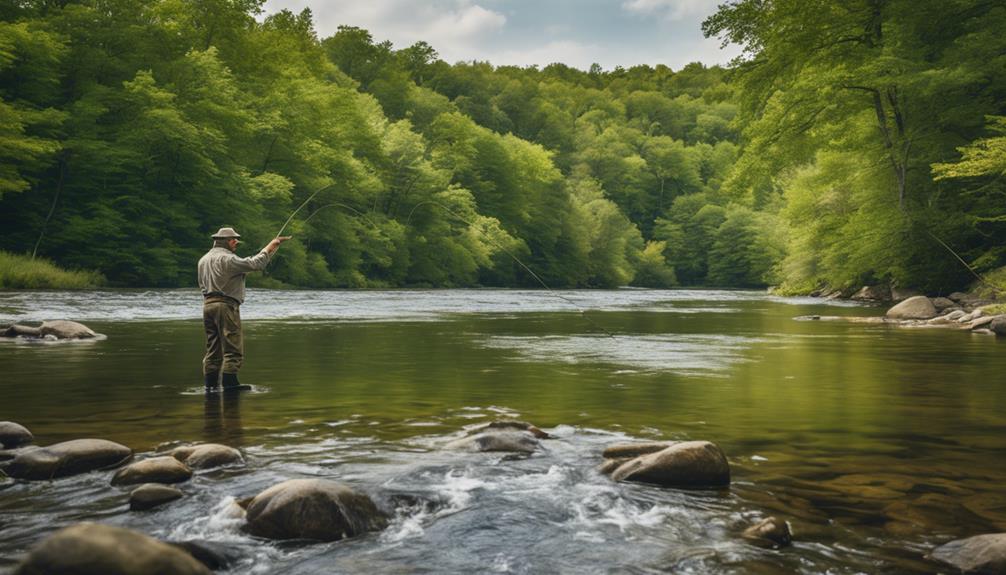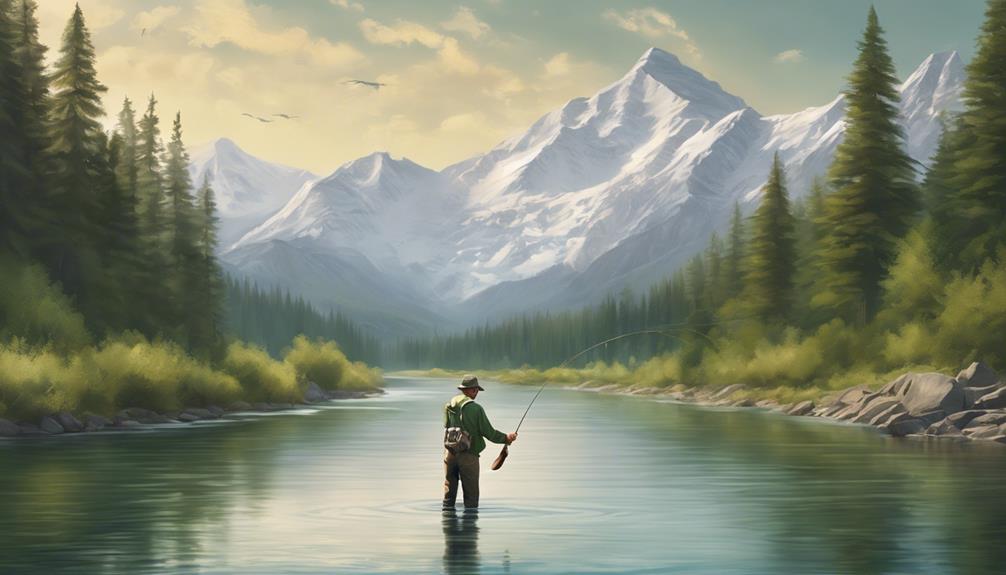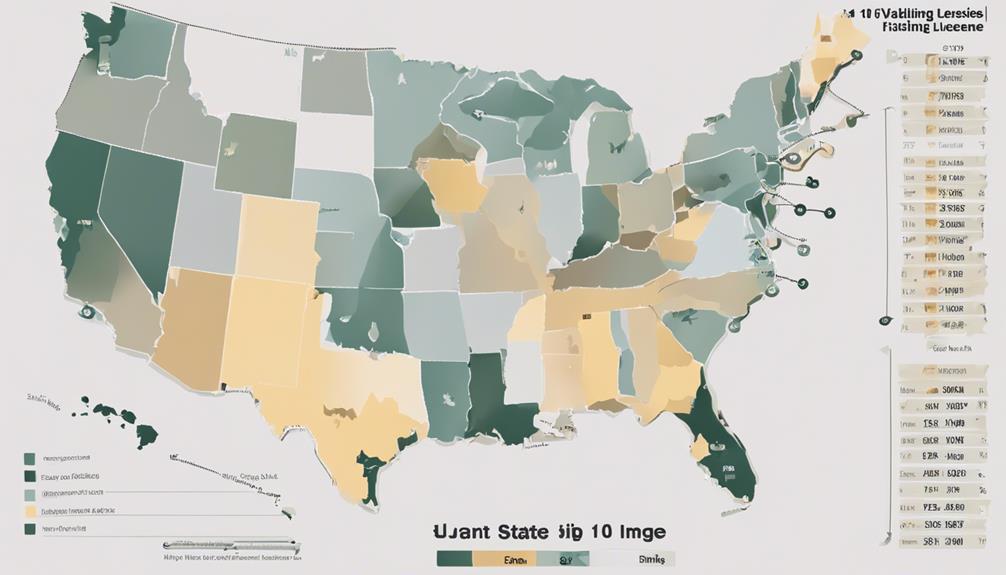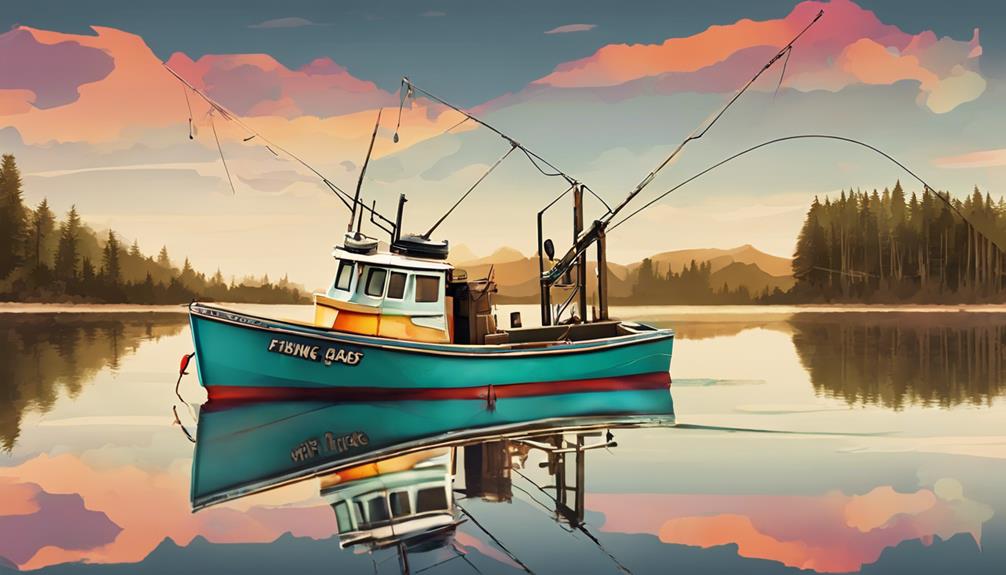You might think fly fishing license policies are about as thrilling as watching paint dry, but hold that thought.
Imagine a world where obtaining your fly fishing permit is not an exercise in bureaucratic frustration but a seamless process that lets you focus on what matters most: casting your line into pristine waters.
From the untamed beauty of Alaska to the rugged terrain of Montana, discover which states offer the most angler-friendly regulations that could elevate your next fishing expedition to new heights.
Alaska's Fly Fishing License Regulations
When planning a fly fishing trip in Alaska, ensure you familiarize yourself with the state's fly fishing license regulations. Alaska prioritizes wildlife conservation through its fishing policies, aiming to protect its diverse aquatic ecosystems and ensure sustainable fishing practices. As an angler, it's essential to respect these regulations to help preserve the natural beauty and abundance of Alaska's fisheries.
Wildlife conservation is a fundamental aspect of fly fishing in Alaska. The state's regulations are designed to safeguard fish populations and their habitats, ensuring that future generations can also enjoy the thrill of fishing in these pristine waters. By obtaining the necessary permits and adhering to catch limits, you play a crucial role in supporting wildlife conservation efforts.
Additionally, angler education is key to promoting responsible fishing practices in Alaska. Before embarking on your fly fishing adventure, take the time to educate yourself on the local fishing regulations and guidelines. By understanding the rules and best practices, you can minimize your impact on the environment and contribute to the overall health of Alaska's fisheries.
Colorado's Fly Fishing Permit Rules
To continue your exploration of fly fishing license regulations, let's now shift our focus to Colorado's Fly Fishing Permit Rules. When it comes to fly fishing in Colorado, the state emphasizes the importance of conservation efforts and promoting catch and release practices. Here are some key points to consider:
- Catch and Release: Colorado encourages anglers to practice catch and release to help sustain fish populations and promote ethical fishing practices.
- Conservation Efforts: The state implements various conservation programs to protect its waterways and the diverse fish species that inhabit them.
- Special Regulations: Certain areas in Colorado may have specific regulations regarding catch limits, bait types, and fishing seasons to ensure sustainable fishing practices.
- Volunteer Opportunities: Anglers in Colorado can get involved in volunteer programs that focus on river clean-ups, habitat restoration, and monitoring fish populations.
- Education and Outreach: Colorado provides educational resources to raise awareness about the importance of conservation and responsible fishing practices.
Montana's Fly Fishing License Laws
Understanding Montana's regulations on fly fishing licenses is essential for any angler planning to fish in the state. Montana has strict fly fishing regulations in place to ensure the sustainability of its fisheries and conservation efforts. To legally fish for trout or other species in Montana waters, anglers aged 12 and older must possess a valid Montana fishing license. Additionally, a Conservation License is required for all residents and nonresidents aged 14-61 years old. These licenses contribute to funding crucial conservation programs that protect Montana's diverse fish populations and their habitats.
When obtaining a fly fishing license in Montana, anglers must adhere to catch limits, size restrictions, and specific fishing seasons to help maintain healthy fish populations. The state actively promotes catch and release practices to preserve the quality of its fisheries. Anglers are encouraged to handle fish with care, use barbless hooks, and practice proper catch and release techniques to minimize harm to fish populations.
Montana's fly fishing regulations also aim to prevent the spread of aquatic invasive species, such as zebra mussels, by requiring anglers to thoroughly clean and dry their gear before entering state waters. By following these regulations, anglers contribute to the protection of Montana's pristine waterways and diverse aquatic ecosystems.
Oregon's Fly Fishing License Requirements
Oregon's Fly Fishing License requirements are essential to know before casting your line in the state's waters. When planning your fly fishing trip in Oregon, make sure you comply with the following guidelines to ensure a smooth and enjoyable experience:
- Fly Fishing License Fees: Before heading out to your favorite fishing spot, make sure to purchase the appropriate fly fishing license. Fees may vary depending on whether you're a resident or non-resident, so be sure to check the current rates.
- Fly Fishing Regulations Compliance: Familiarize yourself with Oregon's fly fishing regulations to avoid any penalties or fines. Regulations may include specific catch limits, size restrictions, and designated fishing areas.
- Conservation Efforts: Respect the environment and practice catch and release to help preserve Oregon's precious fish populations for future generations.
- Ethical Fishing Practices: Always follow ethical fishing practices, such as proper handling of fish, using barbless hooks, and respecting other anglers on the water.
- Safety Precautions: Prioritize safety by wearing appropriate gear, informing someone of your fishing plans, and being aware of your surroundings at all times.
Wyoming's Fly Fishing License Policies
When fishing in Wyoming, ensure you adhere to the state's fly fishing license policies to avoid any legal complications. Wyoming is renowned for its exceptional trout management, offering anglers a variety of opportunities to fish for different trout species in its pristine waters. The state's conservation efforts play a crucial role in maintaining healthy fish populations and preserving the natural habitats that make Wyoming a prime destination for fly fishing enthusiasts.
To participate in the fantastic fly fishing Wyoming has to offer, you must obtain the appropriate fishing license. The state offers various options for residents and non-residents, including daily and annual permits. Make sure to familiarize yourself with the specific regulations and requirements based on the type of fishing experience you seek. By following these guidelines, you contribute to the sustainability of Wyoming's fisheries and help protect its valuable ecosystems.
Trout management is a top priority in Wyoming, with conservation efforts aimed at preserving the diverse trout populations found in the state's waters. By obtaining a fly fishing license and abiding by the regulations, you actively support these conservation initiatives. Whether you're casting your line in the iconic waters of the Snake River or exploring the hidden gems of the Wind River Range, Wyoming's fly fishing license policies are designed to enhance your angling experience while safeguarding the natural environment for future generations.
Idaho's Fly Fishing Permit Guidelines
To enjoy fly fishing in Idaho, ensure you have the necessary permit in accordance with the state's guidelines. Idaho's fly fishing permit guidelines are crucial for maintaining the sustainability of the state's fisheries and ensuring a memorable angling experience. When obtaining your permit, keep in mind the following key points:
- Catch limits: Respect the catch limits set by Idaho's fishing regulations to help preserve fish populations and maintain a healthy ecosystem.
- Conservation efforts: Support Idaho's conservation efforts by following best practices such as proper catch and release techniques to protect fish populations for future generations.
- Responsible angling: Practice responsible angling by properly disposing of fishing line and hooks to prevent harm to wildlife and the environment.
- Educational resources: Take advantage of educational resources provided by Idaho Fish and Game to learn more about local fish species, habitats, and conservation initiatives.
- Community involvement: Get involved in local conservation projects and initiatives to contribute to the preservation of Idaho's fisheries and natural resources.
New York's Fly Fishing License Stipulations

Ensure you acquire the necessary fly fishing license in New York to comply with state regulations and enjoy a successful angling experience. When it comes to fly fishing in New York, there are specific stipulations you need to be aware of to ensure you're fishing legally and responsibly.
In New York, there are age restrictions for obtaining a fly fishing license. Anglers aged 16 and older are required to have a fishing license to fish in the state's waters legally. It's essential to verify the age requirements before heading out to fish to avoid any potential legal issues.
For out-of-state anglers looking to fly fish in New York, there are specific license fees that apply. Non-resident fishing licenses are available for various durations, such as one-day, seven-day, or annual licenses. The fees for out-of-state licenses vary depending on the duration of the license, so make sure to check the latest fee schedule to ensure compliance with New York's regulations.
Utah's Fly Fishing License Restrictions
Utah imposes specific restrictions on fly fishing licenses that anglers must adhere to when planning their fishing excursions in the state. To ensure sustainable fishing practices and the preservation of natural resources, Utah has implemented regulations that promote conservation efforts and protect its diverse aquatic ecosystems.
- Limited access: Some fly fishing areas in Utah have limited access to maintain the delicate balance of fish populations and their habitats. By restricting access to certain locations, the state aims to prevent overfishing and preserve the quality of the fishing experience for all anglers.
- Catch and release policies: Utah encourages catch and release practices to help maintain healthy fish populations. Anglers are urged to release certain species back into the water to support conservation efforts and ensure the long-term viability of the fishery.
- Seasonal closures: Certain rivers and streams in Utah may have seasonal closures to protect fish during sensitive times such as spawning seasons. These closures are vital for the sustainability of fish populations and contribute to the overall health of the aquatic environment.
- Size and possession limits: Utah enforces size and possession limits on various fish species to prevent the depletion of populations. Adhering to these limits is crucial in supporting conservation efforts and preserving the natural balance of aquatic ecosystems.
- Barbless hook requirements: Using barbless hooks is often mandatory in Utah to minimize harm to fish and facilitate their safe release. This regulation is designed to reduce stress on fish populations and promote responsible angling practices.
Frequently Asked Questions
Can Fly Fishing Licenses Be Purchased Online in These States?
Yes, fly fishing licenses can be conveniently purchased online in many states. This option offers you easy accessibility to obtain the necessary license without having to visit a physical location.
Requirements for purchasing online licenses may include age restrictions or other eligibility criteria. Check with your state's fishing regulations to ensure you meet all necessary requirements before making your online purchase.
Are There Any Age Restrictions for Obtaining a Fly Fishing License in These States?
When it comes to fly fishing licenses, age restrictions vary by state. Some states have minimum age requirements, typically around 16 or 18 years old, while others may not have any specific age restrictions.
Enforcement policies usually ensure that individuals meet the age requirements before obtaining a license. It's important to check the regulations in your state to make sure you meet the necessary criteria before purchasing a fly fishing license.
Do These States Offer Discounted or Free Fly Fishing Licenses for Veterans or Senior Citizens?
In some states, veterans and senior citizens may be eligible for discounted or free fly fishing licenses, showing appreciation for their service and dedication.
This initiative not only benefits these individuals but also contributes to conservation efforts and promotes sustainability in fishing practices.
Additionally, these discounts can encourage more participation in fishing tournaments and competitions, fostering a sense of community and camaraderie among anglers of all ages.
Are There Any Specific Regulations Regarding Catch-And-Release Practices in These States?
When fly fishing in these states, you should know that conservation efforts and ethical practices are key. Regulations on catch-and-release practices vary. Some states may have specific rules to protect fish populations.
Additionally, fish stocking and habitat restoration play a significant role in maintaining healthy ecosystems. Always be mindful of these guidelines to ensure the sustainability of fishing resources and the preservation of natural habitats.
What Are the Penalties for Fishing Without a Valid Fly Fishing License in These States?
If you're caught fishing without a valid fly fishing license in these states, you could face penalties like fines, citations, or even having your fishing equipment confiscated.
Enforcement agencies in these areas are vigilant about upholding conservation practices and regulations to protect the environment and fish populations.
Make sure to always have your license with you while fishing to avoid any run-ins with the authorities.
Conclusion
Overall, when it comes to fly fishing license policies, Alaska, Colorado, Montana, Oregon, Wyoming, Idaho, New York, and Utah stand out as some of the best states to consider. Each state offers unique regulations and requirements for obtaining a fly fishing permit, ensuring that anglers can enjoy their favorite pastime while also supporting conservation efforts.
So, whether you're a seasoned angler or just starting out, these states provide a great opportunity to experience the thrill of fly fishing in a responsible and sustainable manner.



